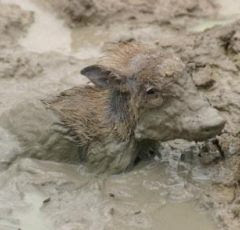Design of the Dry-Stack Rock Buttress at the Rosemont Copper Mine south of Tucson, Arizona.
There is a growing use of the practice of dewatering tailings using vacuum or pressure filters so the tailings can then be stacked. More and more mines are choosing to filter press their tailings and place the tailings in a stack. Dry Stacking is increasing because of the need to reduce water consumption; the need to limit seepage from the tailings; and the imperative to build a stable stack not subject to slope failure, breaching or collapse. The water savings reduces the impacts on the environment and leaves the tailings in a dense and stable arrangement and eliminates the long-term liability that ponds leave after mining is finished.
AMEC, Mt. Polley's British engineering firm, also oversees the Raglan Mine, a large nickel mining complex in the Nunavik region of northern Quebec, where, as AMEC reports, "Approximately 700,000 tonnes/year of tailings are deposited over the estimated remaining life of the mine of about 15 years, with the possibility of increasing the production rate and/or the length of mine life. Tailings solids comprise about 70% silt sizes. Immediately prior to filtering, the tailings stream is thickened, with thickener underflow at 60-65% solids. Filtered tailings are loaded on trucks, hauled to Tailings Repository, dumped, spread and compacted to form a stable stack with 5H:1V side slopes." Obviously AMEC is/was well qualified to design a filter-pressed tailings stack operation for Imperial Metals...but, we'll get to the but in a minute.
The Greens Creek Filter-Pressed Dry-Stack operation.
Dry Stacking is happening all around the globe where ever progressive governments and far-sighted corporations understand the long term economics of mining, where ever they understand what externalized costs are and who always ends up paying them. By definition:"If external costs exist, such as pollution, the producer may choose to produce more of the product than would be produced if the producer were required to pay all associated environmental costs."
Here comes the but, All the experts agree but say, "There are potential merits to dry stacked tailings these systems are often cost prohibitive due to increased capital cost to purchase and install the filter systems and the increase in operating costs (generally associated electricity consumption and consumables such as filter cloth) of such systems."
Like so many other issues where short-term corporate and banking interests are allowed to escape paying the full cost of their operation through limited liability or because regulations are shoddy [often due to corrupt governments being bought off by moneyed interests] the corporate management does their job which is to maximize shareholder's quarterly profits.
So when you hear or read something about the Mount Polley collapse and the cost of remediation [estimated at $400millionCdn] remember that you'll pay that cost as soon as Imperial Metals' $15millionCdn insurance policy runs dry. Remember too that you and your children are paying for every environmental disaster that spewed pollution into the commonly owned biosphere since the corporations and banks figured out how to run this racket.
Commodity prices are soaring, corporate profits are soaring, but the corporations never have any dough for precaution, the governments never have any dough for social justice or schools, or safety inspectors or ...tomorrow the prime mover of buts, the free trade but...or is that butt?














